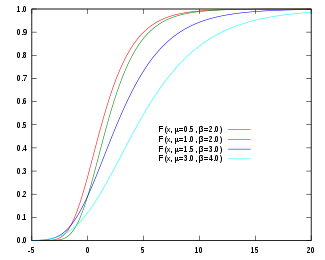| Revision as of 15:58, 28 February 2012 edit209.2.220.236 (talk) →Properties← Previous edit | Revision as of 16:12, 28 February 2012 edit undo209.2.220.236 (talk) →Mean zero Gumbel distributionNext edit → | ||
| Line 62: | Line 62: | ||
| You can also specify the mean zero Gumbel distribution as | You can also specify the mean zero Gumbel distribution as | ||
| :<math>F(x)=\exp(-e^{(\gamma+\phi x)}) </math> | :<math>F(x)=\exp(-e^{(\gamma+\phi x)}) </math> | ||
| where the mean is 0 and standard deviation is <math>\frac{\pi ^2} { 6 \phi^2} </math> | for <math>\phi>0</math>where the mean is 0 and standard deviation is <math>\frac{\pi ^2} { 6 \phi^2} </math> | ||
| ==Parameter estimation== | ==Parameter estimation== | ||
Revision as of 16:12, 28 February 2012
Probability density function | |||
Cumulative distribution function | |||
| Parameters |
location (real) scale (real) | ||
|---|---|---|---|
| Support | |||
|
where | |||
| CDF | |||
| Mean | |||
| Median | |||
| Mode | |||
| Variance | |||
| Skewness | |||
| Excess kurtosis | |||
| Entropy | |||
| MGF | |||
| CF | |||
In probability theory and statistics, the Gumbel distribution (named after Emil Julius Gumbel (1891–1966)) is used to model the distribution of the maximum (or the minimum) of a number of samples of various distributions. For example we would use it to represent the distribution of the maximum level of a river in a particular year if we had the list of maximum values for the past ten years. It is useful in predicting the chance that an extreme earthquake, flood or other natural disaster will occur.
The potential applicability of the Gumbel distribution to represent the distribution of maxima relates to extreme value theory which indicates that it is likely to be useful if the distribution of the underlying sample data is of the normal or exponential type.
The Gumbel distribution is a particular case of generalized extreme value distribution (also known as the Fisher-Tippett distribution) and the distribution is also known as the log-Weibull distribution and the double exponential distribution (which is sometimes used to refer to the Laplace distribution). It is often incorrectly labelled as Gompertz distribution.
Properties

The cumulative distribution function of the Gumbel distribution is
The median is
The mean is where = Euler–Mascheroni constant 0.5772156649015328606.
The standard deviation is
The mode is μ.
Standard Gumbel distribution
The standard Gumbel distribution is the case where μ = 0 and β = 1 with cumulative distribution function
and probability density function
The median is 0.36651292058166432701.
The mean is , the Euler–Mascheroni constant 0.5772156649015328606.
The standard deviation is
- 1.28254983016186409554.
The mode is 0.
Mean zero Gumbel distribution
You can also specify the mean zero Gumbel distribution as
for where the mean is 0 and standard deviation is
Parameter estimation
A more practical way of using the distribution could be
where M is the median. To fit values one could get the median straight away and then vary μ until it fits the list of values.
Generating Gumbel variates
Given a random variate U drawn from the uniform distribution in the interval , the variate
has a Gumbel distribution with parameters μ and β. This follows from the form of the cumulative distribution function given above.
Related distributions
When the cdf of Y is the converse of the Gumbel standard cumulative distribution, , then Y has a Gompertz distribution.
Application

Gumbel has shown that the maximum value (or first order statistic) in a sample of a random variable following an exponential distribution approaches the Gumbel distribution closer with increasing sample size.
In hydrology, therefore, the Gumbel distribution is used to analyze such variables as monthly and annual maximum values of daily rainfall and river discharge volumes, and also to descibe droughts.
Gumbel has also shown that the estimator r / (n+1) for the probability of an event - where r is the rank number of the observed value in the data series and n is the total number of observations - is an unbiased estimator of the cumulative probability around the mode of the distribution. Therefore, this estimator is often used as a plotting position.
The blue picture illustrates an example of fitting the Gumbel distribution to ranked maximum one-day October rainfalls showing also the 90% confidence belt based on the binomial distribution. The rainfall data are represented by the plotting position r / (n+1) as part of the cumulative frequency analysis.
See also
- Type-1 Gumbel distribution
- Type-2 Gumbel distribution
- Extreme value theory
- Generalized extreme value distribution
- Fisher–Tippett–Gnedenko theorem
- CumFreq (application software for probability distributions including Gumbel)
References
- Willemse, W. J. and Kaas, R., "Rational reconstruction of frailty-based mortality models by a generalisation of Gompertz’ law of mortality", Insurance: Mathematics and Economics, 40 (3) (2007), 468–484.
- Gumbel, E.J. 1954. "Statistical theory of extreme values and some practical applications". Applied Mathematics Series, 33. U.S. Department of Commerce, National Bureau of Standards.
- Ritzema (ed.), H.P. (1994). Frequency and Regression Analysis (PDF). Chapter 6 in: Drainage Principles and Applications, Publication 16, International Institute for Land Reclamation and Improvement (ILRI), Wageningen, The Netherlands. pp. 175–224. ISBN 90 70754 3 39.
{{cite book}}:|last=has generic name (help) - Burke, E.J.; Perry R.H.J.; Brown, S.J. (2010) "An extreme value analysis of UK drought and projections of change in the future", Journal of Hydrology
















 where
where  =
=  0.5772156649015328606.
0.5772156649015328606.



 0.36651292058166432701.
0.36651292058166432701.
 1.28254983016186409554.
1.28254983016186409554.
 where the mean is 0 and standard deviation is
where the mean is 0 and standard deviation is 



 , then Y has a
, then Y has a